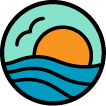This Bomb-Covered Island May Soon Host Rare Bunnies
Noman’s Land, off Martha’s Vineyard, has gone from practice target to potential rabbit sanctuary.

Every day of Islands Week, we’re profiling one uninhabited island. Find more here.
Nomans Land Island, a 600-acre chunk of land off the coast of Massachusetts, is well-named. Sure, people did live there once: Over the years, it’s been home to Native Americans, cod fishers, farmers, and bootleggers, all of whom built structures and spun local lore. At one point the island even hosted a family of isolationists, one of whom “had been possessed by the spirit of a Boston milliner and was given to frenzies of hat trimming.”
In 1943, though, the U.S. Navy leased the island from its owner, cleared the place out, and started using it as a 600-acre practice target. For the next 53 years, they salted the island liberally with bombs. As so often happens for birds and other animals, the lack of human residents outweighed the regular explosions, and in 1998, the land was declared a National Wildlife Refuge. It remains closed to the public, lest they disturb unhatched eggs or unexploded ordnance. So, save for the occasional visit by the U.S. Fish and Wildlife Service, the land is once again no man’s.


Although if a new proposal goes through, it will instead belong to a lot of bunnies. The FWS recently announced a plan to fill Nomans Land with New England cottontails, a native species of rabbit that has been outcompeted by the introduced Eastern variety.
According to the Fish and Wildlife Service, the island could host up to 600 or more bunnies, who would live out their lives unmenaced by mammalian predators, with great access to shrubs and other helpful vegetation. A similar proposal—to fill an uninhabited island in the Quabbin Reservoir with timber rattlesnakes—was nixed last year after pushback from shoreline residents, but this one seems destined to succeed. Bunnies and bombs: What could go wrong?











Follow us on Twitter to get the latest on the world's hidden wonders.
Like us on Facebook to get the latest on the world's hidden wonders.
Follow us on Twitter Like us on Facebook